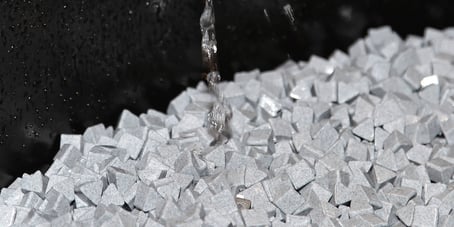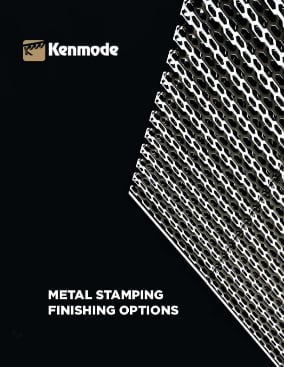The metal stamping process uses heavy tonnage presses to form a wide variety of metal materials, which can produce burrs – excess metal in a rough or raised area on the part’s surface or ragged or sharp edges. Typically, specifications for metal stampings provide for 10% of material thickness as the burr allowance. However, complex parts may require that the burrs be reduced either through a more complex stamping process or by a deburring method after stamping. The metal stamper can provide guidance on the part’s design to meet critical specifications, the expected burr, its impact on the part’s tolerances, and the best method of deburring, if needed.
Reasons for Deburring Metal Stampings
Many stampings that require deburring are made of steel or stainless steel, copper or brass.
According to the Precision Metalforming Association (PMA) Design Guidelines, “Deburring is normally done for three main reasons:
- for safe handling (in-service and during manufacture);
- to avoid abrasive/cutting effects (for example, on insulated wires); and
- to enhance surface appearance”
“Other reasons to deburr include removing discoloration from welding or brazing, as well as removing unwanted foreign contaminants, oxidation, rust, and scale from heat treatment,” PMA adds. For example, if a part has a sharp edge, it may cause problems in handling during assembly or in its function, where it may result in abrasion or wear issues.
“Most of the deburring we do for stampings is to meet specifications for an edge break or a radius edge,” explains Tommy Polte, vice president of Sno-Belt Industries in Woodstock, Illinois. He notes that stampings that need deburring can range in size from miniature up to 16 x 6 inches.
How Deburring Works
The bulk deburring processes most commonly used for stampings are barrel and vibratory finishing, which either tumble or vibrate the parts in an abrasive media and a cleaning solution. Electropolishing also is an option for micro-deburring of complex parts, although it is more expensive. Both barrel and vibratory finishing remove oil and other foreign contaminants, along with sharp edges and burrs. Electropolishing removes surface metal, which can provide a mirror-like finish.
Barrel Deburring
Barrel Deburring works as a part-on-part process, where the parts hit each other in an enclosed tub as it rotates, eliminating burrs. Barrel deburring can handle large volumes but can only be used for sturdy parts.
Vibratory Deburring
Vibratory Deburring makes use of an oscillating channel and is used for more delicate stampings.
“The media used depends on the configuration of the part and the type of metal,” Mr. Polte notes. “The media can range from the size of BBs to two-inch stones.”
He adds that deburring media includes:
- Corn cobs, which are ground to the consistency of sand and sawdust
- Ceramic
- Stone
- Plastic
- Aluminum oxide, a gritty powder that acts as an abrasive like sandpaper
Electropolishing
Electropolishing removes a thin outer layer of metal and any contaminants by immersing the parts in a tank filled with a blended chemical electrolyte bath that is subjected to an electrical current. This method is preferred for delicate and intricate stampings with critical dimensions that could be damaged during barrel or vibratory deburring. According to Able Electropolishing, “During the process, the transfer of metal ions occurs most rapidly on corners or edges of metal parts. Current density or concentration of electrochemical power is greatest at high points, just as lightning is drawn to tall trees and buildings. This helps explain why plating builds metal faster on an edge or burr, while electropolishing (the ‘reverse’ of plating) removes metal fastest at these points.” However, electropolishing does not work for large burrs or heavy die breaks.
Stamped Metal Parts Commonly Deburred
- Terminals
- Brackets
- Medical device components
- Washers
Solicit Deburring Recommendations from a Metal Stamping Engineer
While manufacturers often specify some type of deburring upfront in the RFQ, metal stamping engineers can provide helpful advice on the expected burrs based on the part’s critical dimensions and suggest the best method for deburring the part. In addition, the metal stamper will recommend an approved deburring and/or electropolishing provider to provide an estimate for the RFQ and then coordinate with the selected firm to schedule the finishing in a timely manner.
Sources: Sno-Belt Industries, Able Electropolishing


